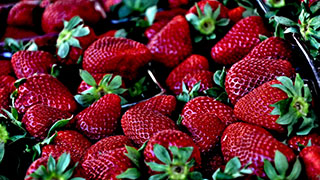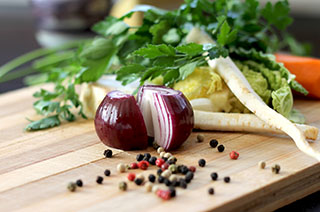What is seasonal eating?
In an age when we can buy pretty much any fruits or vegetables, at any time, in our supermarkets you may not believe that there was a time when you could only get certain produce at certain times of the year. With factory farming methods and modern technology, the supermarkets can supply us with nearly anything we want to eat, but it might not always be tasty. We’ve all picked up a plump juicy strawberry from the fruit aisle only to find that it tastes bland and sour. That’s because it was probably grown in a greenhouse or flown in from another country where they are picked before they are ready and ripened in transit.
We all want to eat food when it’s at its tastiest right? Well there is a time of year when all fruit and vegetables are at their ripest and most delicious. Fruit and vegetables grow in natural cycles. During different seasons each year, fruits and vegetables come into “season” and are at their tastiest and most nutritious. For example, asparagus starts to emerge from the ground in the spring and are crisp and full of flavour. Later on in the year they will become less tasty and tough. In the summer strawberries will taste sweet and delicious. Late summer sees the best tomatoes, sweet, juicy and ripened by the summer sun. Autumn brings us pumpkins and squashes and root vegetables like carrots and parsnips arrive in the winter months.
Why should you eat seasonal food?
Government findings during a 12-month research project into food purchases show that almost three quarters of people questioned look to buy British fruit and vegetables and there are a wide range of benefits to choosing to eat British food when in season:
- You are supporting your local economy and British farmers.
- It is better for the environment. Produce is grown by local farmers which means it does not need to be grown in greenhouses or flown in from other countries, reducing energy and CO2 emissions.
- It’s generally cheaper as the produce hasn’t been transported across the world or intensively farmed.
- The food is fresher, more nutritious and above all more delicious.
Where can you buy seasonal british food
- Farmers’ markets
- Local food markets
- Organic or local veg box schemes
- Supermarkets - Just be sure to check what’s in season with our guide when you go shopping and ensure the fruit or veg you choose comes from British producers
- Grow your own!
Our guide to what’s in season throughout the year
Winter (Dec to Feb): Apple, brussels sprouts, cabbage (savoy and white), carrot, cauliflower, leek, onion, parsnip, pear, potato, pumpkin, purple sprouting broccoli, rhubarb (forced), swede, turnip.
Spring (Mar to May): apple, asparagus, brussels sprouts, cabbage (savoy), carrot, cauliflower, cucumber, lettuce, onion, parsley (flat -leaf), potato, purple sprouting broccoli, radish, red onion, rhubarb.
Summer (Jun to Aug): Apple, basil, beans (runner and French), beetroot, broccoli, carrot, cauliflower, celery, courgette, cucumber, fennel, lettuce, onion, potato, radish, raspberry, red onion, rocket, rhubarb, strawberry.
Autumn (Sep to Nov): Apple, blackberry, butternut squash, Brussels sprouts, cabbage (savoy and spring green), carrot, cauliflower, celery, kale, leek, onion, parsnip, pear, potato, pumpkin, purple sprouting broccoli, spinach, turnip.
 5 ideas to make the most of this spring’s seasonal produce
5 ideas to make the most of this spring’s seasonal produce
- Purple Sprouting Broccoli: Simply trim off any woody parts and divide the florets into equal sizes. Best cooked for 3 - 6 minutes in boiling water, drained and tossed in butter and lemon juice. It’s also a great addition to stir fries.
- Red onions: Slice thinly and add these mild onions to salads or salsas. Roast in the oven or bake whole for 45 mins with butter, honey, thyme and balsamic vinegar.
- Carrots: Grate and add to coleslaw or use a peeler to add fine slices to a salad. For sweet and sticky roast carrots bake whole in the oven with butter or olive oil and a drizzle of honey until tender and jammy.
- Cauliflower: For a chilly spring day warm up with a hearty bowl of Cauliflower cheese. Parboil the florets first for 5 minutes then transfer to a baking dish and cover with a rich cheese sauce. Sprinkle over extra cheese and breadcrumbs then bake in the oven for 20 mins.
- Rhubarb: An excellent addition to porridge when stewed with a touch of sugar and honey or when turned into a crumble it will rarely disappoint!
Written by Mike Pye
i